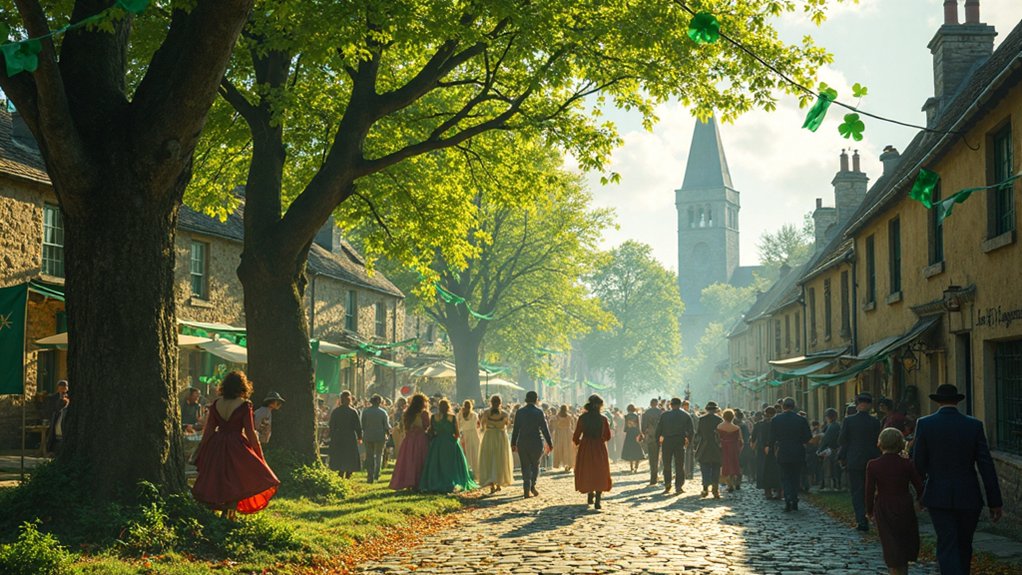
What is the meaning of St Patrick’s Day
Beneath the green festivities of St. Patrick's Day lies a profound legacy; discover how these traditions shape our celebrations today.


If you’re curious about how Saint Patrick’s Day traditions began, you’re not alone. The story of how Saint Patrick’s Day traditions took root in Ireland is a fascinating blend of history and culture. Originally, Saint Patrick’s Day traditions started as religious observances honoring Saint Patrick, the patron saint who helped spread Christianity across Ireland.

Over the centuries, these Saint Patrick’s Day traditions evolved from quiet church services into lively parades, music, and global celebrations. Today, millions of people around the world embrace Saint Patrick’s Day traditions, from wearing green to enjoying festive gatherings, making it one of the most widely celebrated cultural holidays.
Saint Patrick, the patron saint of Ireland, is a legendary figure whose life and mission have shaped Irish history.
Saint Patrick was born in Britain and famously kidnapped by Irish pirates, only to later return to Ireland with a mission to spread Christianity.
Saint Patrick is best known for using simple symbols, like the shamrock, to teach important lessons about faith, love, and forgiveness.
Today, Saint Patrick’s legacy continues to inspire millions, and his story is celebrated across Ireland and around the world every year.
Early Saint Patrick’s Day celebrations in Ireland marked the beginning of a beloved tradition.
As Christianity spread across the country, local communities honored Saint Patrick with special gatherings, combining religious ceremonies with cultural customs. People would join together for feasts, lively processions, and storytelling, sharing tales of Saint Patrick’s miracles.
These early Saint Patrick’s Day celebrations in Ireland not only strengthened faith but also brought people closer as a community.
Today’s vibrant festivities can be traced back to these early Saint Patrick’s Day celebrations in Ireland, reflecting the enduring spirit and unity of the Irish people.
The symbolism of the shamrock is deeply rooted in Irish culture and tradition. The shamrock, a three-leafed plant, is most famously associated with Saint Patrick’s Day and is recognized worldwide as a symbol of Ireland.
The symbolism of the shamrock is often linked to the Holy Trinity—representing the Father, the Son, and the Holy Spirit. According to legend, Saint Patrick used the symbolism of the shamrock to explain the core beliefs of Christianity to the Irish people.
Today, the symbolism of the shamrock continues to unite people with Ireland’s rich heritage, making it a cherished emblem to wear or display during Saint Patrick’s Day celebrations.
The spread of Christianity in Ireland was a turning point that deeply influenced the nation’s culture and traditions.
As the spread of Christianity in Ireland gained momentum, missionaries like Saint Patrick traveled across the countryside, introducing new beliefs and blending them with existing customs.
The spread of Christianity in Ireland helped to unite communities, inspire new celebrations, and create a lasting spiritual legacy that continues to shape Irish identity today.
Saint Patrick’s Day has evolved from its religious roots into a vibrant, global celebration. Today, Saint Patrick’s Day is marked by lively parades, festive parties, and people everywhere wearing green, no matter their background.
This transformation of Saint Patrick’s Day into a secular holiday means that everyone can take part in the festivities, celebrating Irish culture and enjoying a strong sense of community.
Whether you have Irish heritage or not, Saint Patrick’s Day invites everyone to join the fun, making March 17 a day for all to come together and celebrate.
Irish immigration has had a profound influence on the way we celebrate Saint Patrick’s Day around the world. As waves of Irish immigrants settled in new countries, they brought their unique customs and traditions with them.
The influence of Irish immigration can be seen in the way these traditions blended with local cultures, creating vibrant celebrations that honor both Irish heritage and multicultural unity.
Today, the influence of Irish immigration is clear in the global popularity of Saint Patrick’s Day, as people from all backgrounds come together to celebrate with parades, music, and community gatherings.
This lasting influence of Irish immigration not only preserves Irish identity but also fosters a spirit of inclusion and togetherness.
Parades are a key feature of modern Saint Patrick’s Day celebrations, bringing communities together to honor Irish heritage. During these lively parades, you’ll experience colorful floats, traditional music, and crowds dressed in green, all reflecting the unique spirit of the holiday.
Parades help strengthen community bonds and create an inclusive atmosphere where everyone is welcome to participate. As a major part of modern traditions, parades not only highlight Irish culture but also encourage unity and togetherness among people from all backgrounds.
Whether you’re a local or a visitor, parades make Saint Patrick’s Day a memorable and joyful tradition for everyone.
Saint Patrick’s Day has become a global phenomenon, celebrated far beyond its Irish origins.
Today, Saint Patrick’s Day festivities can be found in major cities like New York, Sydney, and Tokyo, where people of all backgrounds wear green, listen to lively Irish music, and savor traditional Irish foods.
The global spread of Saint Patrick’s Day highlights the power of cultural celebrations to bring people together, fostering a sense of unity and joy around the world.
Whether you have Irish roots or simply want to join the fun, Saint Patrick’s Day offers everyone a chance to experience the magic and camaraderie of this special holiday.
Many people enjoy Saint Patrick’s Day for its lively parades and festive atmosphere, but the true meaning of Saint Patrick’s Day goes much deeper.
The true meaning of Saint Patrick’s Day is rooted in ancient Irish traditions, where wearing green and coming together as a community celebrated unity and good fortune.
When you participate in traditional music, dance, and feasting, you honor the true meaning of Saint Patrick’s Day by connecting with Ireland’s rich cultural history.
Every element of this holiday—from the parades to the songs—reminds us of the true meaning of Saint Patrick’s Day and its centuries-old origins.
To sum up, Saint Patrick’s Day traditions have a fascinating history, evolving from quiet religious ceremonies to lively celebrations of Irish culture around the world. The story of Saint Patrick and the significance of the shamrock have been central to Saint Patrick’s Day traditions, inspiring everything from wearing green to festive parades. Thanks to Irish immigration, Saint Patrick’s Day traditions have spread far beyond Ireland, allowing people everywhere to join in the excitement.
Whether you’re attending a parade, sharing a meal, or simply putting on something green, you’re helping keep Saint Patrick’s Day traditions alive and celebrating the rich heritage of this global holiday.

Beneath the green festivities of St. Patrick's Day lies a profound legacy; discover how these traditions shape our celebrations today.

To understand why Abraham Lincoln declared Thanksgiving a national holiday, one must delve into the turbulent era of the Civil War and its deeper meanings.

Curious about Halloween’s ancient origins? Discover the Celtic, Roman, and Christian influences that shaped this spooky celebration and what they reveal today.

Analyze the beliefs of five religions that skip Halloween festivities—discover the reasons behind their choices and what they celebrate instead.

Originating from ancient Celtic rituals, Halloween traditions evolved through time—what unexpected influences helped shape this hauntingly festive celebration? Discover the intriguing history behind it.

Wondering how to elevate your Thanksgiving celebration? Discover essential tips that will transform your gathering into a memorable experience.